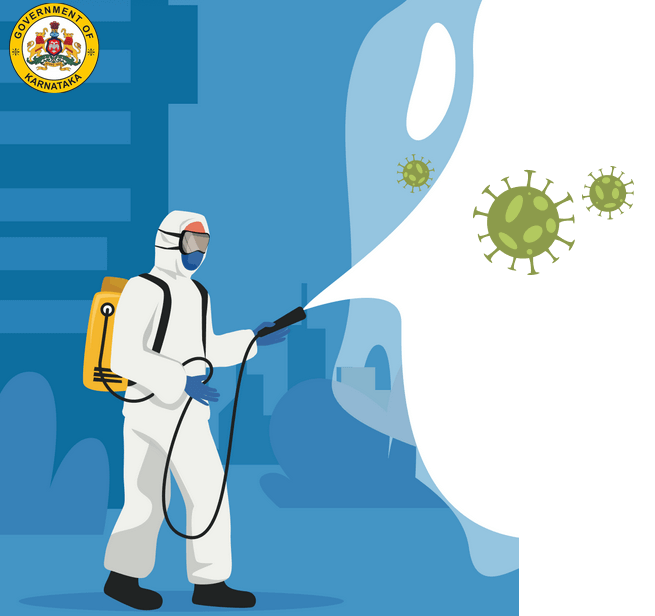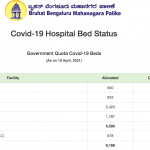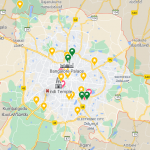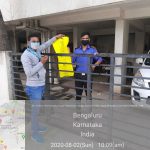

By Manasa Manjunath
First things first, my story is not a testimony of COVID-19 cases in India being on a steady decline. It is my personal experience about the protocols in place and the precautions taken by the citizens of Bengaluru.
Originally from Bengaluru, I did my schooling and bachelors in engineering here. I moved to Germany nine years ago to pursue my masters. I moved to Stuttgart for a job, where I’ve lived for over five years now. Last December, I arrived here alongside my husband and was pleasantly surprised by the way the city and the people are dealing with the pandemic.
Let’s start with international arrivals. Before flying to India, a self-declaration form is to be filled online, besides installing the Aarogya Setu mobile application. Further, international fliers have to install the Apthamitra and Quarantine watch apps, and a COVID negative result (a pan-India requirement) to reduce quarantine.
My husband and I took the RT-PCR (Real-Time Reverse Transcription Polymerase Chain Reaction) test two days before flying and were given a hard copy of our negative certificates. During check-in at the Frankfurt airport, our self-declaration forms and phones were checked to ensure that we had installed the required apps, besides noting down our contact details. So far so good.
While flying out, I noticed that all restaurants except McDonald’s were closed at the Frankfurt airport, barring bakeries. Safety enforcement was quite lax even as many lined up at the on-ground test center at the airport. There were a few hand sanitizing stations, but there was nobody to enforce the wearing of masks and social distancing. No one at the ticketing office had a mask on their persons. Other than the check-in, there were no other new protocols for international fliers; none that came to my notice. We went through immigration and boarded just as normal. We flew through Dubai and the flight was mostly empty.
On landing in Dubai, passengers traveling to India were again checked for the self-declaration form, the necessary mobile applications, and our contact details were noted again. Pretty meticulous. The flight to Bengaluru was full. When we arrived in Bengaluru, there was an airport official immediately outside the plane monitoring everyone. We were asked to form two separate lines with ample social distancing and walked up to two thermal screening stations where all the incoming passengers were screened. Then our temperatures and oxygen levels were noted, following which our COVID-19 negative results and self-declaration forms were collected.
And all of this before immigration! After immigration and baggage collection, as we were about to exit the airport, our passports were checked again, and we were asked to quarantine for seven days at home. I saw hand sanitizing stations at hundred to two-hundred meter intervals throughout the airport and each one we tested worked fine!
When in Germany
Germany also requires a self-declaration form to be filled out before flying. However, COVID negative certificates became mandatory only recently. At check-in, our self-declaration form was checked, and plenty of hand sanitizing stations were available from entry to boarding. Immigration and boarding progressed as usual.
We had a direct flight to Frankfurt while returning from Bangalore and the flight was packed. When we reached Frankfurt, there was no monitoring of the arrivals for social distancing, no thermal or any other sort of screening of passengers. When we landed, there were two airport officials right outside, but ‘Welcome to Germany’ is all they said. They didn’t appear to be monitoring anything.
At immigration, I was asked to show my self-declaration but my husband was not even asked for that. Apart from that, there were no other COVID-19 protocols in place. I don’t remember seeing a single hand sanitizing station from the flight till immigration, though there was one station immediately after immigration. Between immigration and baggage claim, there were some (I didn’t see more than four-five) hand sanitizing stations positioned randomly. At baggage claim, there were two hand sanitizing stations for five baggage carousels, and one of them didn’t even work. This wouldn’t be alarming had Frankfurt been a small airport but seeing how it is Germany’s biggest and an international hub for Lufthansa, it was unexpected. The COVID-19 protocols, except for closing restaurants and duty-free, and throwing in some hand sanitizing stations into the mix, were quite lax.
The behavior of the general public
Let’s talk about public behavior. Everywhere I went in Bengaluru, after quarantining at home for a week, I noticed people wearing masks in public – in shops, on roads, even the ones riding bikes and in their cars. Police on the roads and store employees also enforced the wearing of masks.
Some would take off their masks in malls for a picture but they came right back on after. The only place where the mask-wearing was shoddy was Malleswaram 8th Cross market as roadside vendors just wore them around their necks. However, the small stores in and around the area provided hand sanitizers and enforced mask-wearing although there were no temperature checks or restrictions on the numbers inside the stores. All shops on MG Road, Brigade Road, and Commercial Street diligently monitored their customers. Temperatures were checked and hands had to be sanitized at all entry points. Some even noted down our contact details. Most shops inside malls and otherwise also required hand sanitization upon entry. Many even had a limit on the number of customers to be allowed inside.
Back in Stuttgart until December, only supermarkets and some stores had hand sanitizers at the entry, but their use wasn’t mandatory or monitored. In some cases, the sanitizers were either empty or not functioning. Customer numbers were limited only when lockdown first lifted in June. Masks were worn only inside shops. Most people on the roads walked around with their masks adorning their elbows, and the concept of social distancing seemed foreign. Of course, I cannot comment on the present situation as we’ve been quarantining at home and are yet to step out.
Initially, in March, the country went into lockdown when the virus first started making rounds around Europe. Schools, gyms, museums, and restaurants were all closed, leaving out the supermarkets and drugstores for necessities. Buses would not allow entry through the front door, only through the middle. We couldn’t even approach the driver to buy tickets. The supermarkets rightfully restricted the sale of toilet paper and flour as people were buying them in bulk.
People could not meet more than one person outside their family, and we were only allowed to leave our houses to buy essentials or for sport – walking, jogging, and the like. We had to maintain social distancing, and working from home became the ‘in’ thing. However, none of this was mandatory as such; there were only advisories being issued. The advisory for masks initially was only in shops and in public transport. In the supermarkets, at the checkout, they had people to monitor the lines and to help ensure nobody was buying up too much toilet paper and flour, funnily enough. This was the case until June when they slowly started opening up. By summer, the country was more or less fully open. Only to go back into soft lockdown in November when the cases started increasing again.
I have grown up in Bengaluru. I understand how India is often criticized and ridiculed in the international media and among westerners as just another poor third world country. However, my personal experience substantiates that Bengaluru is implementing strict COVID-19 protocols. No wonder, the city has managed to keep its head above water, and the people seem to be cooperative and aware of what is happening around them.
Manasa Manjunath is a 31-year-old automotive engineer working in Stuttgart, Germany
(As told to Aratrika Dey)




